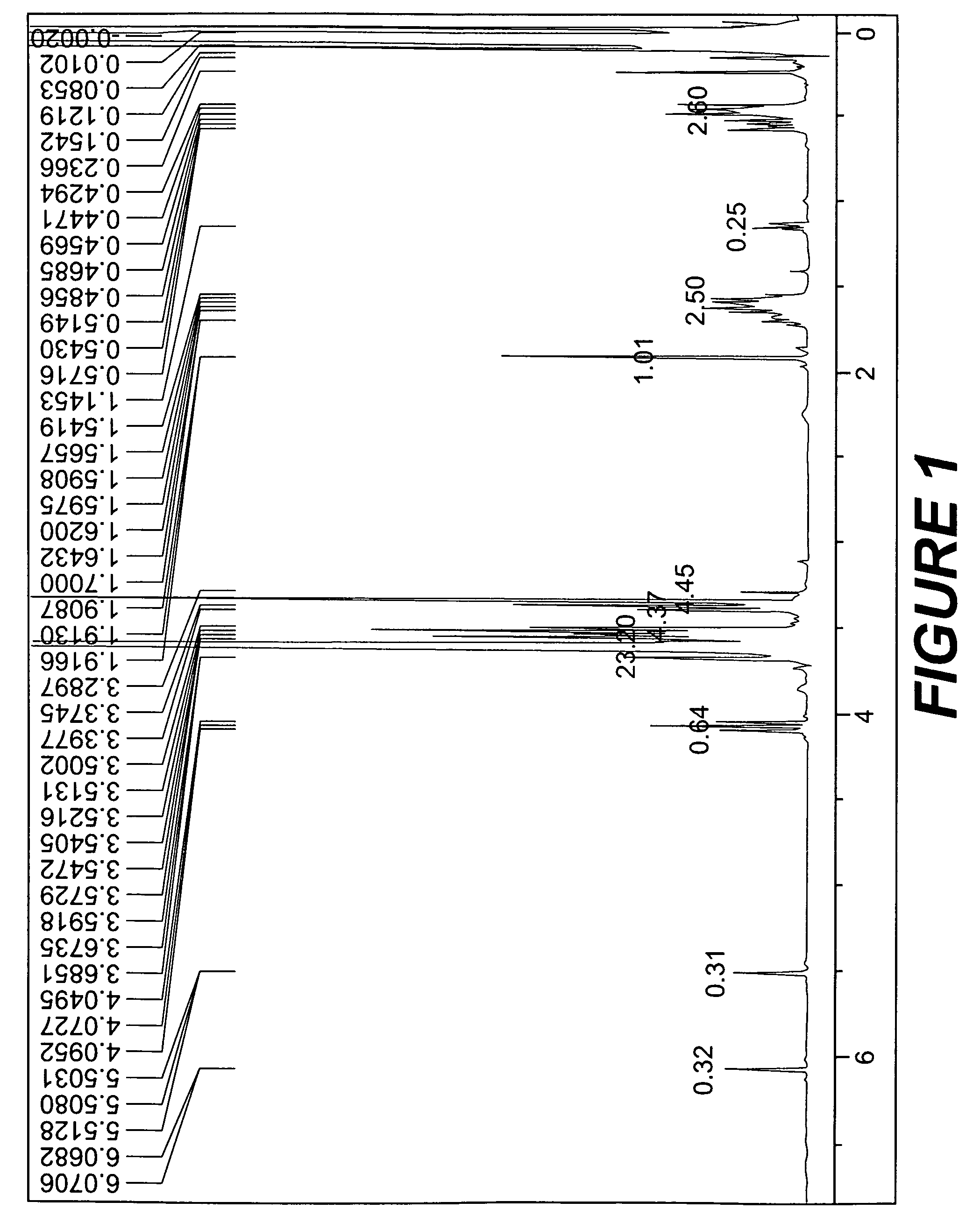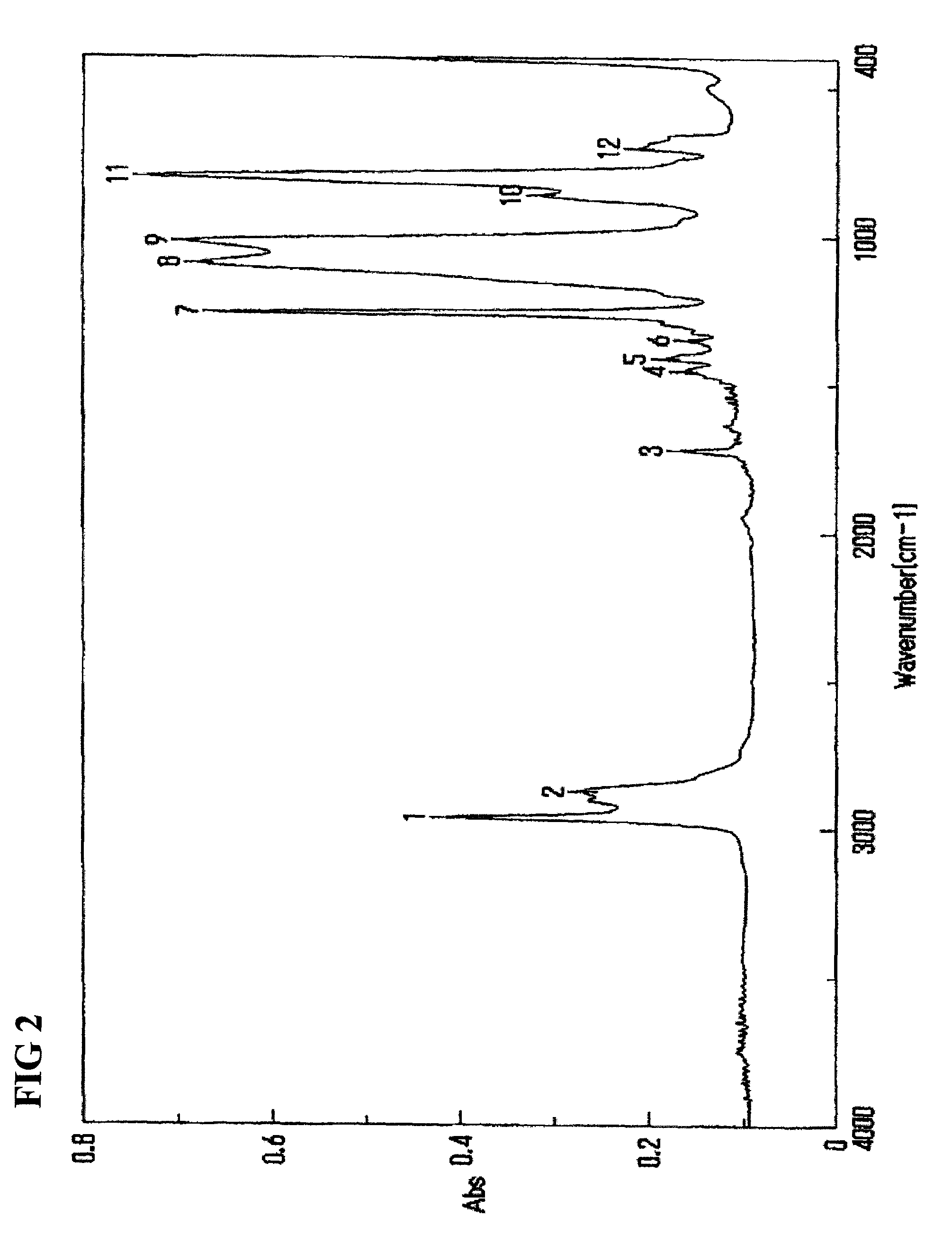Hydrophilic polysiloxane macromonomer, and production and use of the same
a macromonomer and hydrophilic technology, applied in the field of ophthalmic lenses, can solve the problems of difficult to obtain adequate strength, difficult to use said polysiloxane as a raw material for an ophthalmic lens with high oxygen permeability and hydrophilicity, and difficult to produce transparent contact lenses. , to achieve the effect of high hydrophilicity, high oxygen permeability and good miscibility
- Summary
- Abstract
- Description
- Claims
- Application Information
AI Technical Summary
Benefits of technology
Problems solved by technology
Method used
Image
Examples
example 1
[0064]9.7 g of 1,3-bis(3-methacryloxypropyl)-1,1,3,3-tetramethyldisiloxane (TSL9706, Momentive), 139 g of octamethylcyclotetrasiloxane (LS8620, Shin-Etsu Chemical), and 7.5 g of 1,3,5,7-tetramethylcyclotetrasiloxane (LS8600, Shin-Etsu Chemical) were dissolved in 170 g of chloroform, and trifluoromethanesulfonic acid (Wako Pure Chemical Industries) was further added, and thereafter this mixture was stirred at 35° C. After 24 hours, 170 g of a 0.5% aqueous sodium hydrogen carbonate solution was added to stop the reaction. After washing five times the reaction solution with 170 g of pure water, the reaction solvent was removed by distillation under a reduced pressure to obtain 140 g of residue. After washing four times the residue with 28 g of acetone and 140 g of methanol, the cleaning liquid was removed by distillation under a reduced pressure to obtain 100 g of an intermediate A.
example 2
[0065]15 g of the intermediate A and 10 g of methoxy polyethylene glycol allyl ether having a molecular weight of about 400 (Uniox PKA5007, NOF Corporation) were dissolved in 30 g of isopropanol, and 0.015 g of potassium acetate and 0.003 g of chloroplatinic acid were further added to the solution, and thereafter this mixture was stirred for 2 hours at 40° C. The reaction solvent was removed by distillation under a reduced pressure, followed by washing the residue with 26 g of acetone and 6.5 g of pure water. After repeating the same washing operation for six times, the cleaning liquid was removed by distillation under a reduced pressure to obtain 13 g of a hydrophilic polysiloxane macromonomer A of interest.
[0066]The structural formula of the synthesized hydrophilic polysiloxane macromonomer is presented in general formula (12), wherein the sequence of siloxane units includes a random sequence. General formula (12) is a hydrophilic polysiloxane macromonomer represented by general f...
example 3
[0070]Synthesis and washing were carried out by the same method as in Example 2, except that methoxy polyethylene glycol allyl ether (Uniox PKA5007) used in Example 2 was substituted with 10 g of polyethylene glycol allyl ether having a molecular weight of about 400 (PKA5002, NOF Corporation), thereby to obtain 13 g of a hydrophilic polysiloxane macromonomer B of interest.
[0071]The results of analysis of 1H-NMR showed that, in the general formula (3), a=about 90, b=about 5, n=about 7, m=0, and R2 was a hydrogen.
PUM
| Property | Measurement | Unit |
|---|---|---|
| reaction temperature | aaaaa | aaaaa |
| reaction temperature | aaaaa | aaaaa |
| reaction temperature | aaaaa | aaaaa |
Abstract
Description
Claims
Application Information
 Login to View More
Login to View More - R&D
- Intellectual Property
- Life Sciences
- Materials
- Tech Scout
- Unparalleled Data Quality
- Higher Quality Content
- 60% Fewer Hallucinations
Browse by: Latest US Patents, China's latest patents, Technical Efficacy Thesaurus, Application Domain, Technology Topic, Popular Technical Reports.
© 2025 PatSnap. All rights reserved.Legal|Privacy policy|Modern Slavery Act Transparency Statement|Sitemap|About US| Contact US: help@patsnap.com



